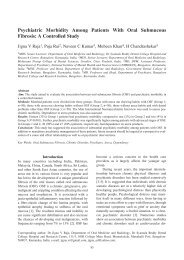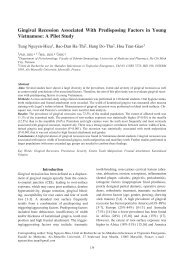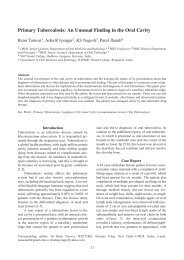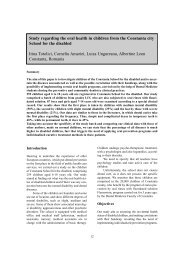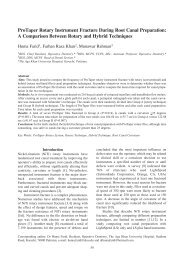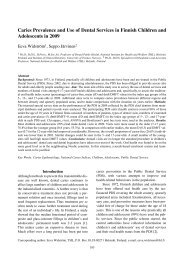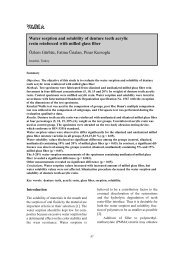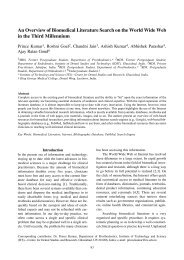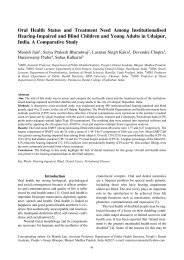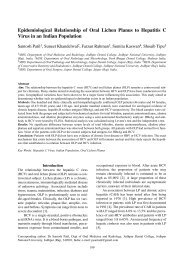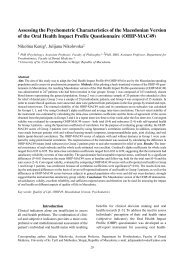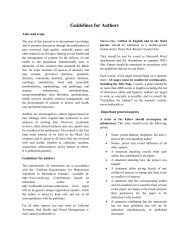Utilization of Stafne's bone cavity for improving complete denture ...
Utilization of Stafne's bone cavity for improving complete denture ...
Utilization of Stafne's bone cavity for improving complete denture ...
You also want an ePaper? Increase the reach of your titles
YUMPU automatically turns print PDFs into web optimized ePapers that Google loves.
VARIA<br />
<strong>Utilization</strong> <strong>of</strong> Stafne’s <strong>bone</strong> <strong>cavity</strong> <strong>for</strong> <strong>improving</strong> <strong>complete</strong> <strong>denture</strong><br />
retention<br />
Idil Dikbas 1 , Temel Koksal 2<br />
Istanbul, Turkey<br />
Summary<br />
This clinical report describes the fabrication <strong>of</strong> a mandibular <strong>complete</strong> <strong>denture</strong> <strong>for</strong> an edentulous<br />
patient with bilateral Stafne’s <strong>bone</strong> cavities. Extension <strong>of</strong> lingual flanges <strong>of</strong> the mandibular <strong>denture</strong><br />
into these cavities has improved the retention <strong>of</strong> the mandibular <strong>denture</strong>.<br />
Key words: Stafne’s <strong>bone</strong> <strong>cavity</strong>, <strong>complete</strong> <strong>denture</strong>, retention.<br />
Introduction<br />
In 1942, Stafne described a series <strong>of</strong><br />
asymptomatic radiolucent lesions located<br />
near the angle <strong>of</strong> the mandible.[1] It is a<br />
well-defined depression in the lingual surface<br />
<strong>of</strong> the posterior body <strong>of</strong> the mandible.<br />
[2] This depression is called “Stafne’s <strong>bone</strong><br />
<strong>cavity</strong>”. Stafne’s <strong>bone</strong> cavities are also<br />
called Stafne defect, Stafne <strong>bone</strong> cyst, static<br />
<strong>bone</strong> <strong>cavity</strong>, latent <strong>bone</strong> cyst, lingual/mandibular<br />
salivary gland depression or lingual/<br />
mandibular defect. [2,3] The etiology is<br />
unknown. [2] Although the defect is<br />
believed to be developmental in nature, it<br />
does not appear to be present from birth. [1]<br />
It has been documented to develop in<br />
patients as old as 30 years and as young as<br />
11 years.[2] Stafne defects are relatively<br />
rare, with an incidence <strong>of</strong> about 0.3%. [4]<br />
More cases have been reported in men than<br />
in women with a striking incidence <strong>of</strong> 80%<br />
to 90% <strong>of</strong> all cases. [1] They are generally<br />
discovered only during radiographic examination<br />
<strong>of</strong> the area as round or ovoid well-circumscribed<br />
radiolucencies. [2,4] Sometimes<br />
the defect may interrupt the continuity <strong>of</strong> the<br />
inferior border <strong>of</strong> the mandible, with a palpable<br />
notch observed clinically in this area.<br />
Most Stafne defects are unilateral, although<br />
bilateral cases may be seen. [1]<br />
Stafne’s <strong>bone</strong> cavities range from 1 to 3<br />
cm in diameter. It is a developmental salivary<br />
gland defect most commonly located<br />
within the submandibular gland fossa and<br />
<strong>of</strong>ten close to the inferior border <strong>of</strong> the<br />
mandible. [2] It can be located more anteriorly<br />
in the mandible in some cases when it<br />
is related to the sublingual gland. [5,6]<br />
This article describes the treatment <strong>of</strong> a<br />
patient in which bilateral Stafne’s cavities<br />
were utilized to improve the stability and<br />
retention <strong>of</strong> a mandibular <strong>complete</strong> <strong>denture</strong>.<br />
Clinical report<br />
A 76-year-old woman presented with<br />
the complaint <strong>of</strong> an ill-fitting mandibular<br />
<strong>denture</strong>. The patient had been edentulous <strong>for</strong><br />
sixteen years. She had been using the last<br />
<strong>denture</strong>s <strong>for</strong> 3 years, but she reported that<br />
she never had been com<strong>for</strong>table with the<br />
mandibular <strong>denture</strong>. Intraoral examination<br />
revealed that the patient’s mucosa was firm<br />
in the maxillary arch but in the mandibula it<br />
was very thin and vulnerable. The maxillary<br />
1 , 2 Assistant Pr<strong>of</strong>essor, DDS, PhD, Department <strong>of</strong> Prosthodontics, Faculty <strong>of</strong> Dentistry, Yeditepe University,<br />
Istanbul, Turkey<br />
40
OHDMBSC - Vol. VI - No. 1 - Martie, 2007<br />
and mandibular residual ridges were<br />
resorbed moderately. Upper and lower dental<br />
arches were V-shaped. Palpation <strong>of</strong> the<br />
lingual surfaces revealed bilateral concavities<br />
in the mandible in the region <strong>of</strong> the<br />
molars. In the panoramic radiography no<br />
pathological lesion was detected at these<br />
regions. It was concluded that the patient<br />
had Stafne’s <strong>bone</strong> <strong>cavity</strong> defects. It was<br />
thought that this depression could be utilized<br />
<strong>for</strong> the retention and stability <strong>of</strong> the<br />
mandibular <strong>denture</strong>.<br />
Preliminary impressions were made<br />
with alginate (Kromopan, Lascod, Italy)<br />
(Figure 1). An individual impression tray<br />
was prepared providing the flanges extending<br />
in length to the concavities. However<br />
auto-polymerizing acrylic resin material<br />
(Meliodent, Bayer, UK) did not engage into<br />
these depressions. During border molding at<br />
the site <strong>of</strong> these concavities, the impression<br />
compound (Kerr Corp, Romulus, U.S.A)<br />
was slightly pushed taking care not to fill<br />
the Stafne’s <strong>bone</strong> cavities. The final impression<br />
was made with a light-body <strong>of</strong> silicone<br />
impression material (Oranwash; Zhermack,<br />
Italy) (Figure 2). After the master cast was<br />
obtained (Figure 3), it was noticed that the<br />
diameters <strong>of</strong> the concavities were approximately<br />
15 mm at the left side, and 9 mm at<br />
the right side. Then the jaw relationships<br />
were determined in the usual manner. The<br />
master casts were mounted on a semiadjustable<br />
articulator (Artex, Girrbach,<br />
Germany), and artificial teeth (Vita,<br />
Zahnfabrik, Germany) were conventionally<br />
arranged. After the try-in session, the <strong>denture</strong><br />
was processed. Initially acrylic resin<br />
(Meliodent; Bayer, UK) was packed on the<br />
cast covered with modeling wax which was<br />
a spacer <strong>for</strong> s<strong>of</strong>t-liner (Molloplast-B,<br />
Buffalo Dental Manufacturing Co., U.S.A.),<br />
and a cellophane was used as a separator to<br />
unpolymerized acrylic resin. The flasked<br />
heat-curing acrylic was placed in the processing<br />
unit <strong>for</strong> 10 minutes at 70°C in order<br />
to reach a consistency hard enough to prevent<br />
the dislodgement during the second<br />
packing. The flask was opened and modeling<br />
wax removed. Then the second packing<br />
was per<strong>for</strong>med with a s<strong>of</strong>t liner material, as<br />
recommended by the manufacturer. The<br />
<strong>denture</strong> was polymerized and polished in the<br />
usual manner (Figure 4) and upper and<br />
lower <strong>denture</strong>s were delivered to the patient.<br />
At the post-insertion recall, there were a few<br />
sore spots and minor adjustments were<br />
made with special burs (Mollplast-Cutters,<br />
Mollplast Regneri GmbH&Co. KG,<br />
Germany) in order to prevent tear <strong>of</strong> the s<strong>of</strong>t<br />
liner. The patient reported she felt com<strong>for</strong>table<br />
and had no difficulty in inserting and<br />
removing the mandibular <strong>denture</strong>.<br />
Figure 1. Mandibular preliminary impression with<br />
bilateral Stafne’s cavities in molar region<br />
Figure 2. Mandibular final impression with bilateral<br />
Stafne’s cavities in molar region<br />
41
OHDMBSC - Vol. VI - No. 1 - Martie, 2007<br />
Figure 3. Stone cast <strong>of</strong> the mandibular arch<br />
Discussion<br />
Stafne’s <strong>bone</strong> cavities may not be diagnosed<br />
visually during intraoral examination<br />
because salivary glands or tissues fill these<br />
cavities. It is obvious that a routine manual<br />
examination <strong>of</strong> all <strong>denture</strong> border areas must<br />
be per<strong>for</strong>med at the initial examination<br />
appointment.<br />
If the patient with Stafne defect refers<br />
<strong>for</strong> fabrication <strong>of</strong> <strong>denture</strong>s, when palpation<br />
is neglected, clinicians could easily miss<br />
these cavities at the intraoral examination.<br />
However they can be noticed after taking<br />
the impression.<br />
In the dental literature there is only one<br />
report [7] that describes the utilization <strong>of</strong><br />
Stafne defects <strong>for</strong> <strong>improving</strong> the retention <strong>of</strong><br />
mandibular <strong>denture</strong>. Heat-curing acrylic<br />
Figure 4. Mandibular <strong>complete</strong> <strong>denture</strong><br />
engaging into these cavities with s<strong>of</strong>t-liner<br />
material must be more preferable as per<strong>for</strong>med<br />
in the present study. In addition it is<br />
advisable that s<strong>of</strong>t liner should be thicker in<br />
the region <strong>of</strong> these cavities. There<strong>for</strong>e the<br />
possibility <strong>of</strong> occurrence <strong>of</strong> some sore spots<br />
during insertion and removal <strong>of</strong> the <strong>denture</strong><br />
decreases, and even if some sore spots are<br />
encountered, thickness <strong>of</strong> the s<strong>of</strong>t liner<br />
makes it possible to grind without exposing<br />
the hard acrylic resin.<br />
Conclusion<br />
This clinical report described the<br />
engagement <strong>of</strong> a mandibular <strong>denture</strong> in<br />
bilateral Stafne’s <strong>bone</strong> cavities. Fabrication<br />
<strong>of</strong> the <strong>denture</strong> by utilizing these cavities<br />
improved the retention and stability <strong>of</strong> the<br />
mandibular <strong>denture</strong>.<br />
References<br />
1. Neville BW, Damm DD, Allen CM, Bouquot<br />
JE. Oral & Maxill<strong>of</strong>acial Pathology. 2nd ed.<br />
Philadelphia: W.B. Saunders Co, 2002; p. 23.<br />
2. White SC, Pharoah MJ. Oral radiology-principles<br />
and interpretation. 4th ed. St. Louis: CV Mosby,<br />
2000; pp. 598-600.<br />
3. Correll RW, Jensen JL, Rhyne RR. Lingual cortical<br />
mandibular defects: a radiographic incidence study.<br />
Oral Surg Oral Med Oral Pathol 1980; 50: 287-291.<br />
4. Ariji E, Fujiwara N, Tabata O, Nakayama E,<br />
Kanda S, Shiratsuchi Y, et al. Stafne’s <strong>bone</strong> <strong>cavity</strong>.<br />
Classification based on outline and content determined<br />
by computed tomography. Oral Surg Oral Med<br />
Oral Pathol 1993; 76: 375-380.<br />
5. Miller AS, Winnick M. Salivary gland inclusion<br />
in the anterior mandible. Report <strong>of</strong> a case with a<br />
review <strong>of</strong> the literature on aberrant salivary gland tissue<br />
and neoplasms. Oral Surg Oral Med Oral Pathol<br />
1971; 31: 790-797.<br />
6. Tominaga K, Kuga Y, Kubota K, Ohba T.<br />
Stafne’s <strong>bone</strong> <strong>cavity</strong> in the anterior mandible: report <strong>of</strong><br />
a case. Dentomaxill<strong>of</strong>ac Radiol 1990; 19: 28-30.<br />
7. Jahangiri L, Jandinski JJ, Flinton RJ. Stafne’s<br />
<strong>bone</strong> <strong>cavity</strong> and its utilization in <strong>complete</strong> <strong>denture</strong><br />
retention. J Prosthet Dent 2002; 87: 245-247.<br />
Correspondence to: Dr. Temel Koksal, DDS, PhD, Bagdat Caddesi No: 238, 34728-<br />
Goztepe, Istanbul, Turkey. E-mail: temel_koksal@yahoo.com<br />
42




